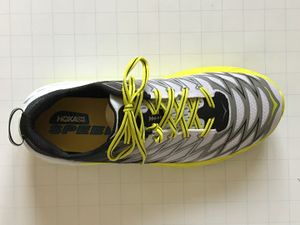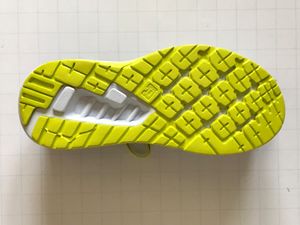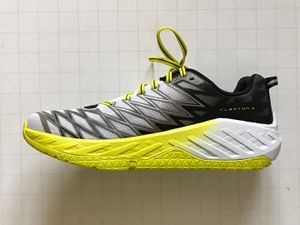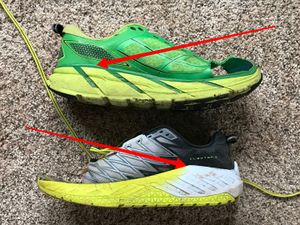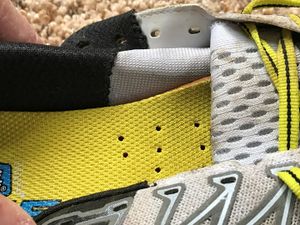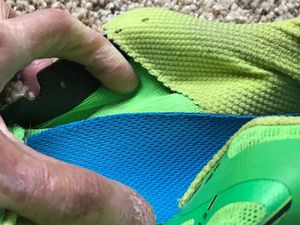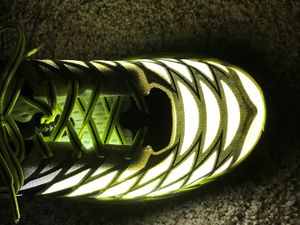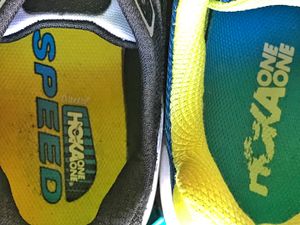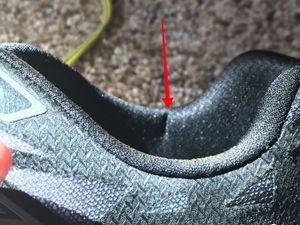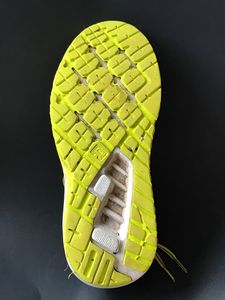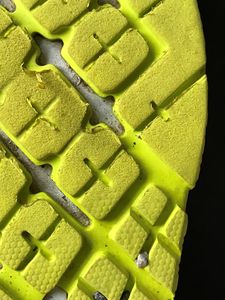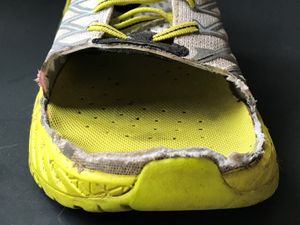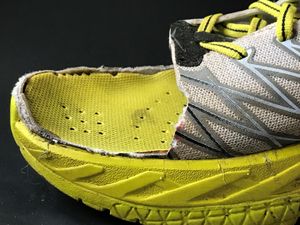Difference between revisions of "Hoka Clayton 2"
User:Fellrnr (User talk:Fellrnr | contribs) |
User:Fellrnr (User talk:Fellrnr | contribs) |
||
| (2 intermediate revisions by the same user not shown) | |||
| Line 1: | Line 1: | ||
{{DISPLAYTITLE:Hoka Clayton 2 Review}} | {{DISPLAYTITLE:Hoka Clayton 2 Review}} | ||
| − | The Hoka Clayton 2 is an incremental change to the original [[Hoka Clayton 1]] and is quite similar to the equally impressive [[Hoka Clifton]]. The Clifton is one of the best selling shoes, and I feel the Clayton is remarkably close in its function and design. Both the Clifton and Clayton have stunning cushioning for their weight, with the Clayton 2 coming in about 1.5oz lighter than the Clifton 3, but with slightly less cushioning. The Clayton uses [[RMAT]] foam as the outsole material, and the current iteration of RMAT works rather well, showing Hoka's growing maturity with this advanced material. [[RMAT]] has great grip on a wide variety of surfaces, including even slick, wet rock. This is something I love in the [[Hoka Mafate]] and [[Hoka Tor Ultra]] boots, and while the Clayton is less likely to be used on torturous trails, the RMAT will make it more competent than you might expect. All this makes RMAT an outstanding outsole as it combines this grip with better cushioning than a traditional rubber and better wear characteristics than an exposed midsole. When you run in the Clayton 2 it feels a lot like the Clifton (both the first and second versions), though I found the upper to be slightly less comfortable, something that's only slightly improved in the Clayton 2. The Clayton feels rather like running barefoot on a softly cushioned track, without undue interference. The Clayton is not a shoe you notice when you're running in it, which is what you want. My main complaint with the Clayton (and most other running shoes) is in the shape of the toe box, which really needs to be cut open. My feet are a fairly typical width, and the Clayton fits me perfectly, other than my toes. The Clayton is rather pricy, so if you're after something with similar cushioning, for less money and with less weight then check out the [[Nike Zoom Streak LT]]. | + | The Hoka Clayton 2 is an incremental change to the original [[Hoka Clayton 1]] and is quite similar to the equally impressive [[Hoka Clifton]]. The Clifton is one of the best selling shoes, and I feel the Clayton is remarkably close in its function and design. Both the Clifton and Clayton have stunning cushioning for their weight, with the Clayton 2 coming in about 1.5oz lighter than the Clifton 3, but with slightly less cushioning. The Clayton uses [[RMAT]] foam as the outsole material, and the current iteration of RMAT works rather well, showing Hoka's growing maturity with this advanced material. [[RMAT]] has great grip on a wide variety of surfaces, including even slick, wet rock. This is something I love in the [[Hoka Mafate]] and [[Hoka Tor Ultra]] boots, and while the Clayton is less likely to be used on torturous trails, the RMAT will make it more competent than you might expect. All this makes RMAT an outstanding outsole as it combines this grip with better cushioning than a traditional rubber and better wear characteristics than an exposed midsole. When you run in the Clayton 2 it feels a lot like the Clifton (both the first and second versions), though I found the upper to be slightly less comfortable, something that's only slightly improved in the Clayton 2. The Clayton feels rather like running barefoot on a softly cushioned track, without undue interference. The Clayton is not a shoe you notice when you're running in it, which is what you want. My main complaint with the Clayton (and most other running shoes) is in the shape of the toe box, which really needs to be cut open. My feet are a fairly typical width, and the Clayton fits me perfectly, other than my toes. The Clayton is rather pricy, so if you're after something with similar cushioning, for less money and with less weight then check out the [[Nike Zoom Streak LT]]. The other problem with the Clayton is that many runners are finding it irritates the arch of the foot, sometimes causing blisters. This problem, combined with the toe box issue, and the rise of competitors like the [[Altra Escalante]] mean I've dropped the rating of the Clayton "Highly Recommended." {{H:WhatToLookForInShoes}} |
<gallery widths=300px heights=300px class="center"> | <gallery widths=300px heights=300px class="center"> | ||
File:Hoka Clayton 2-top.jpg|Hoka Clayton 2 top view. | File:Hoka Clayton 2-top.jpg|Hoka Clayton 2 top view. | ||
| Line 14: | Line 14: | ||
* {{H:flexibility}}. The Clayton 2 is reasonably flexible for shoe of this thickness, and the practical flexibility is a little greater than my metrics might suggest. The softness of the midsole allows the ball of your foot to sink in and creates some effective flexibility for your foot. | * {{H:flexibility}}. The Clayton 2 is reasonably flexible for shoe of this thickness, and the practical flexibility is a little greater than my metrics might suggest. The softness of the midsole allows the ball of your foot to sink in and creates some effective flexibility for your foot. | ||
* {{H:outsole}}. The Clayton uses [[RMAT]] as the outsole material. This is not as hard wearing as a true blown rubber outsole, but because it's a lot more cushioned than rubber, the overall cushioning-to-weight ratio is much better than you might expect in a shoe that has an outsole covering virtually the entire contact patch. The [[RMAT]] material also has remarkably good traction, far better than the traction you'd get in a traditional rubber outsole. For wet asphalt, it's arguably comparable to the hard plastic nubs found in ultralight shoes like the [[New Balance RC5000v2]], though on slicker surface the Clayton's RMAT will win every time. | * {{H:outsole}}. The Clayton uses [[RMAT]] as the outsole material. This is not as hard wearing as a true blown rubber outsole, but because it's a lot more cushioned than rubber, the overall cushioning-to-weight ratio is much better than you might expect in a shoe that has an outsole covering virtually the entire contact patch. The [[RMAT]] material also has remarkably good traction, far better than the traction you'd get in a traditional rubber outsole. For wet asphalt, it's arguably comparable to the hard plastic nubs found in ultralight shoes like the [[New Balance RC5000v2]], though on slicker surface the Clayton's RMAT will win every time. | ||
| − | * {{H:shape}}. The Clayton 2 has the typical Hoka shape, which includes a horribly constricted toe box. A superficial inspection might make you think the Clayton is a little wider, but I think this is an optical illusion created by the wider midsole. I've noticed at Ultras the Hoka toe box causes a distinctive pattern of blisters, so it's critical to [[Shoe Dissection| cut open the toe box of any Hokas]]. {{H:TryCuttingShoes}} | + | * {{H:shape}}. The Clayton 2 has the typical Hoka shape, which includes a horribly constricted toe box. A superficial inspection might make you think the Clayton is a little wider, but I think this is an optical illusion created by the wider midsole. I've noticed at Ultras the Hoka toe box causes a distinctive pattern of blisters, so it's critical to [[Shoe Dissection| cut open the toe box of any Hokas]]. {{H:TryCuttingShoes}}. Even with my skin condition, I've had no problems with blisters once the toe box is cut open. However, I've had a number of reports of runners getting blisters on the arch of their foot. The Clayton 2 is very similar to most other Hoka shoes around the arch, but I did notice one significant difference. Virtually all Hokas, including the Clayton 2, have a midsole that rises up to cup the heel and some of the midfoot. When the midsole rises up near the arch, all other Hoka shoes I checked (and I checked quite a few) have an insole that rises up to cover the midsole. On the Clayton 2 however, the insole does not cover the midsole, and I suspect this is the cause of the blisters. |
| + | <gallery widths=300px heights=300px class="center"> | ||
| + | File:Hoka Clayton 2 Arch Issues (2).jpg| Like most Hokas, the Clayton 2 has a midsole that rise up around the arch of the foot. | ||
| + | File:Hoka Clayton 2 Arch Issues (3).jpg| Here you can see the inside of the shoe, with the upper folded back to show where the midsole comes to. You can see that the midsole rises well above where the insole ends. | ||
| + | File:Hoka Clayton 2 Arch Issues (1).jpg|By comparison, in other Hoka shoes the insole comes much higher and covers the midsole. | ||
| + | </gallery> | ||
* {{H:upper}}. The upper is largely seamless, with moderate to poor breathability due to the number of overlays. There is a one seam in the midfoot where a small amount of padding is added to the rear of the shoe, and there is an odd bit of sewing at the ankle opening (see image below.) There is far less padding in the Clayton 2 than I'd have expected, and vastly less around the ankle opening than a shoe like the [[Hoka Clifton]]. There ankle opening in the Clayton 2 has a very slight improvement over the original Clayton, but it's enough that I didn't find it uncomfortable. | * {{H:upper}}. The upper is largely seamless, with moderate to poor breathability due to the number of overlays. There is a one seam in the midfoot where a small amount of padding is added to the rear of the shoe, and there is an odd bit of sewing at the ankle opening (see image below.) There is far less padding in the Clayton 2 than I'd have expected, and vastly less around the ankle opening than a shoe like the [[Hoka Clifton]]. There ankle opening in the Clayton 2 has a very slight improvement over the original Clayton, but it's enough that I didn't find it uncomfortable. | ||
<gallery widths=300px heights=300px class="center"> | <gallery widths=300px heights=300px class="center"> | ||
| Line 24: | Line 29: | ||
* {{H:lacing}}. The Clayton uses thin flat laces which stay tied. The laces have a slight bit of elasticity in them, improving the overall comfort of the shoe. (They appear to be the same lace that Hoka used in the Clifton.) | * {{H:lacing}}. The Clayton uses thin flat laces which stay tied. The laces have a slight bit of elasticity in them, improving the overall comfort of the shoe. (They appear to be the same lace that Hoka used in the Clifton.) | ||
* {{H:heelcounter}}. I could not detect any [[Heel Counter]] in the Clayton, though the upper has an overlay in that part of the shoe that ensures it maintains its shape when you're putting it on. | * {{H:heelcounter}}. I could not detect any [[Heel Counter]] in the Clayton, though the upper has an overlay in that part of the shoe that ensures it maintains its shape when you're putting it on. | ||
| + | =Update after 340 Miles= | ||
| + | I try to write update on running shoes after about 200 miles, but I found I've done over 300 before I'd even written the overall review. Many runners have complained about the arch causing blisters, for which I dropped the rating from its previous "best of the best" to "highly recommended", but I've not had any issues personally. As you can see from the photos below, I had to cut open the toe box immediately due to its horrible shape, but this is a fairly pervasive issue with modern running shoes. I've been surprised just how well this shoe is held up to the miles. You can see a little bit of wear on the outsole, but that's fairly minor in the scale of things. I'd estimate that I've lost about 1 mm of outsole in the heaviest wear areas under the ball of my foot, and it's not overly localized, so this is not causing any unnatural foot movement. There is some compression of the midsole foam under the ball of my foot, but far less than I would've expected, amounting to probably only 1-2 mm, which means that there is a surprising amount of life left in these shoes. This is a little surprising, as the harder wearing [[RMAT]] outsole phone does not appear to make up a huge portion of the overall cushioning. Speaking of RMAT, I've been extremely pleased with the level of grip is outsole material provides, especially in the wet or other slick conditions. | ||
| + | <gallery widths=300px heights=300px class="center"> | ||
| + | File:Clayton2_340Miles (4).jpg| This is an overview of the outsole, and you may be able to make out some of the wear pattern, though it's fairly minor. | ||
| + | File:Clayton2_340Miles (3).jpg| A close up of the area under the ball of my foot shows the abrasion a little more clearly. You may need to click to get a bigger image, but you'll see that the bottom right edge of the picture shows the outsole that still has the original embossed pattern, that is worn away from other points. You also get a sense of how much the cross in the center of each pad has disappeared as the outsole has worn. | ||
| + | File:Clayton2_340Miles (1).jpg| Looking at the insole, you'll notice there is no noticeable compression of the midsole foam, reflecting a surprisingly resilient shoe. | ||
| + | File:Clayton2_340Miles (2).jpg| even though I've cut the toe box open, there's no sign of wear or stress on the upper. To be fair, I've only had a couple of shoes that have ever had any issues with their upper after the toe box has been cut open, who's running shoes are made of tough materials. | ||
| + | </gallery> | ||
=A Comparison with other Recommended Shoes= | =A Comparison with other Recommended Shoes= | ||
{{:Shoes-include}} | {{:Shoes-include}} | ||
Latest revision as of 15:19, 14 August 2017
The Hoka Clayton 2 is an incremental change to the original Hoka Clayton 1 and is quite similar to the equally impressive Hoka Clifton. The Clifton is one of the best selling shoes, and I feel the Clayton is remarkably close in its function and design. Both the Clifton and Clayton have stunning cushioning for their weight, with the Clayton 2 coming in about 1.5oz lighter than the Clifton 3, but with slightly less cushioning. The Clayton uses RMAT foam as the outsole material, and the current iteration of RMAT works rather well, showing Hoka's growing maturity with this advanced material. RMAT has great grip on a wide variety of surfaces, including even slick, wet rock. This is something I love in the Hoka Mafate and Hoka Tor Ultra boots, and while the Clayton is less likely to be used on torturous trails, the RMAT will make it more competent than you might expect. All this makes RMAT an outstanding outsole as it combines this grip with better cushioning than a traditional rubber and better wear characteristics than an exposed midsole. When you run in the Clayton 2 it feels a lot like the Clifton (both the first and second versions), though I found the upper to be slightly less comfortable, something that's only slightly improved in the Clayton 2. The Clayton feels rather like running barefoot on a softly cushioned track, without undue interference. The Clayton is not a shoe you notice when you're running in it, which is what you want. My main complaint with the Clayton (and most other running shoes) is in the shape of the toe box, which really needs to be cut open. My feet are a fairly typical width, and the Clayton fits me perfectly, other than my toes. The Clayton is rather pricy, so if you're after something with similar cushioning, for less money and with less weight then check out the Nike Zoom Streak LT. The other problem with the Clayton is that many runners are finding it irritates the arch of the foot, sometimes causing blisters. This problem, combined with the toe box issue, and the rise of competitors like the Altra Escalante mean I've dropped the rating of the Clayton "Highly Recommended." These reviews are not being maintained. If you want trustworthy and detailed reviews, check out Run Repeat Shoe Reviews. If I'd continued doing running shoe reviews, I'd want to produce a site like run repeat. I used The Science of Running Shoes as the basis of how I tested running shoes and what you should look for in a running shoe.

| This review was made possible by readers like you buying products via my links. I buy all the products I review through normal retail channels, which allows me to create unbiased reviews free from the influence of reciprocity, or the need to keep vendors happy. It also ensures I don't get "reviewer specials" that are better than the retail versions.
|
1 Characteristics
- Cushioning . The Clayton 2 has the massive cushioning that made Hoka famous, and in a shoe that is remarkably light. The cushioning-to-weight ratio is almost identical to the Hoka Clifton 3, which is about the best of the Maximalist shoes. You can get better cushioning-to-weight ratios, but only in much lighter shoes like the Nike Zoom Streak LT, New Balance RC5000, or the amazing New Balance RC5000v2. The Hyper Speed has similar levels of overall cushioning to the Clayton, though the Hyper Speed has more cushioning in the heel and less in the forefoot. Surprisingly (to me at least), is the Saucony Kinvara 8, which has better cushioning than the Clayton for slightly less weight.
- Drop. The Clayton has about a 1mm drop when loaded, down from 5mm when measured without the weight of a runner.
- Structure. The Clayton has two types of foam, a traditional EVA foam used as the midsole, and a much tougher RMAT foam used as the outsole. The combination of these two foams does not interfere with your biomechanics in the way that would occur with a medial post. In the midsole cups the heel of the foot, which tends to create a little unobtrusive stability. The midsole does arise up under the arch, but I didn't find this will cause enough to cause any planter fasciitis issues. I found the taper at the front of the Clayton when the midsole thins between the ball of the foot and the toes to be quite smooth and natural (Hoka refers to this as the "rocker ".) One improvement over the first version is that the midsole no longer extends out from the outside edge of the forefoot so much.
- Flexibility. The Clayton 2 is reasonably flexible for shoe of this thickness, and the practical flexibility is a little greater than my metrics might suggest. The softness of the midsole allows the ball of your foot to sink in and creates some effective flexibility for your foot.
- Outsole. The Clayton uses RMAT as the outsole material. This is not as hard wearing as a true blown rubber outsole, but because it's a lot more cushioned than rubber, the overall cushioning-to-weight ratio is much better than you might expect in a shoe that has an outsole covering virtually the entire contact patch. The RMAT material also has remarkably good traction, far better than the traction you'd get in a traditional rubber outsole. For wet asphalt, it's arguably comparable to the hard plastic nubs found in ultralight shoes like the New Balance RC5000v2, though on slicker surface the Clayton's RMAT will win every time.
- Shape. The Clayton 2 has the typical Hoka shape, which includes a horribly constricted toe box. A superficial inspection might make you think the Clayton is a little wider, but I think this is an optical illusion created by the wider midsole. I've noticed at Ultras the Hoka toe box causes a distinctive pattern of blisters, so it's critical to cut open the toe box of any Hokas. (I recommend cutting open the toe box of virtually all running shoes, with the exception of a few shoes like some Altra shoes. When you have some worn out shoes, you should try cutting open the toe box. I've found that it's a big improvement, allowing my toes to move naturally and engage for toe off, as well as reducing the possibility of blisters.). Even with my skin condition, I've had no problems with blisters once the toe box is cut open. However, I've had a number of reports of runners getting blisters on the arch of their foot. The Clayton 2 is very similar to most other Hoka shoes around the arch, but I did notice one significant difference. Virtually all Hokas, including the Clayton 2, have a midsole that rises up to cup the heel and some of the midfoot. When the midsole rises up near the arch, all other Hoka shoes I checked (and I checked quite a few) have an insole that rises up to cover the midsole. On the Clayton 2 however, the insole does not cover the midsole, and I suspect this is the cause of the blisters.
- Upper. The upper is largely seamless, with moderate to poor breathability due to the number of overlays. There is a one seam in the midfoot where a small amount of padding is added to the rear of the shoe, and there is an odd bit of sewing at the ankle opening (see image below.) There is far less padding in the Clayton 2 than I'd have expected, and vastly less around the ankle opening than a shoe like the Hoka Clifton. There ankle opening in the Clayton 2 has a very slight improvement over the original Clayton, but it's enough that I didn't find it uncomfortable.
- Tongue. The Clayton 2 has a normal tongue rather than a tongue-less sock style of upper, and the tongue is slightly padded. With the flat laces which are closely spaced, I don't think runners will have an issue with pressure from the laces on the top of the foot.
- Lacing. The Clayton uses thin flat laces which stay tied. The laces have a slight bit of elasticity in them, improving the overall comfort of the shoe. (They appear to be the same lace that Hoka used in the Clifton.)
- Heel Counter. I could not detect any Heel Counter in the Clayton, though the upper has an overlay in that part of the shoe that ensures it maintains its shape when you're putting it on.
2 Update after 340 Miles
I try to write update on running shoes after about 200 miles, but I found I've done over 300 before I'd even written the overall review. Many runners have complained about the arch causing blisters, for which I dropped the rating from its previous "best of the best" to "highly recommended", but I've not had any issues personally. As you can see from the photos below, I had to cut open the toe box immediately due to its horrible shape, but this is a fairly pervasive issue with modern running shoes. I've been surprised just how well this shoe is held up to the miles. You can see a little bit of wear on the outsole, but that's fairly minor in the scale of things. I'd estimate that I've lost about 1 mm of outsole in the heaviest wear areas under the ball of my foot, and it's not overly localized, so this is not causing any unnatural foot movement. There is some compression of the midsole foam under the ball of my foot, but far less than I would've expected, amounting to probably only 1-2 mm, which means that there is a surprising amount of life left in these shoes. This is a little surprising, as the harder wearing RMAT outsole phone does not appear to make up a huge portion of the overall cushioning. Speaking of RMAT, I've been extremely pleased with the level of grip is outsole material provides, especially in the wet or other slick conditions.
A close up of the area under the ball of my foot shows the abrasion a little more clearly. You may need to click to get a bigger image, but you'll see that the bottom right edge of the picture shows the outsole that still has the original embossed pattern, that is worn away from other points. You also get a sense of how much the cross in the center of each pad has disappeared as the outsole has worn.
3 A Comparison with other Recommended Shoes

| If you're looking for "the best of the best" running shoe, here are my top picks. Of course, the answer will depend a little on what you're looking for, so I have recommendations for various categories.
|
For a more detailed on running shoes see the Recommendations for Best Running Shoes. This table lists the key attributes of What to Look for in Running Shoes. For more detailed information, on the shoes see detailed shoe comparison.
|
Full Review ▼ |
Brand ▼ | Name | Rating | Recommended price |
Benefit | Weight (oz) |
Penalty (sec/mile) |
Forefoot Thickness |
Heel Thickness |
Loaded Drop mm |
Cushioning | Flexibility |
|---|---|---|---|---|---|---|---|---|---|---|---|---|
| Saucony Type A Review | Saucony | A/A7 | Recommended | $100 | 6.4 | 6.7 | 12.1 | 19 | 22 | 1 | 4.3 | 7 |
| Saucony Type A6 Review | Saucony | A6 | Highly Recommended | $100 | 8.2 | 6.1 | 9.5 | 17 | 21 | 4 | 5.0 | 7 |
| Saucony Type A8 Review | Saucony | A8 | Highly Recommended | $90 | 7.5 | 6.2 | 9.7 | 19 | 20 | -1 | 4.7 | 7 |
| Adidas Adios Boost 2 Review | Adidas | Adios | Worth considering | $140 | 4.7 | 8.6 | 13.4 | 17 | 27 | 11 | 4.0 | 6 |
| Hoka Bondi 5 Review | Hoka | Bondi | Recommended | $150 | 6.1 | 11.6 | 18.1 | 38 | 42 | 5 | 7.1 | 2 |
| Hoka Clayton 2 Review | Hoka | Clayton2 | Highly Recommended | $150 | 9.1 | 8.3 | 12.9 | 23 | 28 | 1 | 7.5 | 5 |
| Hoka Clifton 4 Review | Hoka | Clifton4 | Worth considering | $130 | 7.7 | 9.3 | 14.5 | 30 | 35 | 10 | 7.2 | 3 |
| ON Cloudflash Review | On Cloud | Cloudflash | Worth considering | $180 | 4.4 | 8.3 | 14.6 | 19 | 26 | 7 | 3.7 | 6 |
| On Cloudracer Review | On Cloud | Cloudracer | Worth considering | $130 | 5.7 | 8.2 | 12.8 | 19 | 27 | 5 | 4.7 | 7 |
| ON Cloud X Review | On Cloud | CloudX | Not recommended | $140 | 4.5 | 8.3 | 16.3 | 21 | 27 | 7 | 3.8 | 7 |
| Mizuno Wave Cruise Review | Mizuno | Cruise | Worth considering | $120 | 6.6 | 5.9 | 12.5 | 17 | 20 | 7 | 3.9 | 6 |
| Newton Distance IV Review | Newton | Distance | Worth considering | $155 | 7.5 | 9.1 | 14.2 | 26 | 31 | 3 | 6.8 | 5 |
| Asics Gel DS Racer 10 Review | Asics | DS Racer | Worth considering | $110 | 8.2 | 7.0 | 10.9 | 21 | 26 | 6 | 5.8 | 5 |
| Altra Duo Review | Altra | Duo | Recommended | $130 | 6.0 | 8.4 | 13.1 | 29 | 29 | 1 | 5.0 | 5 |
| Mizuno Wave Ekiden 8 Review | Mizuno | Ekiden | Worth considering | $115 | 5.7 | 5.7 | 14.6 | 13 | 18 | 6 | 3.2 | 8 |
| Saucony Endorphin 2 Review | Saucony | Endorphin 2 | Worth considering | $115 | 8.0 | 5.1 | 9.6 | 15 | 13 | -1 | 4.1 | 8 |
| Adidas Energy Boost Review | Adidas | Energy | Worth considering | $160 | 7.2 | 10.0 | 15.6 | 20 | 30 | 7 | 7.2 | 5 |
| Altra Escalante Review | Altra | Escalante | Best of the Best | $130 | 9.1 | 8.7 | 13.5 | 28 | 25 | -1 | 7.9 | 6 |
| Altra Escalante 1.5 Review | Altra | Escalante 1.5 | Best of the Best | $130 | 8.2 | 9.0 | 14.0 | 26 | 27 | -1 | 7.4 | 7 |
| Saucony Fastwitch Review | Saucony | Fastwitch | Highly Recommended | $90 | 9.5 | 7.1 | 11.1 | 20 | 22 | 4 | 6.8 | 7 |
| Topo Fli-Lyte 2 Review | Topo | Fli-Lyte2 | Highly Recommended | $100 | 6.7 | 9.1 | 14.2 | 24 | 26 | 3 | 6.1 | 5 |
| Reebok Floatride Run Review | Reebok | Floatride | Worth considering | $150 | 7.7 | 9.6 | 14.9 | 28 | 34 | 10 | 7.4 | 5 |
| Saucony Freedom Review | Saucony | Freedom | Recommended | $160 | 5.4 | 10.7 | 16.6 | 25 | 29 | 3 | 5.8 | 6 |
| Skechers GORun 4 Review | Skechers | GORun | Not recommended | $100 | 6.1 | 7.5 | 11.7 | 15 | 23 | 3 | 4.5 | 7 |
| Skechers GOrun Ultra 2 Review | Skechers | GRU | Worth considering | $90 | 7.5 | 10.0 | 15.6 | 28 | 34 | 8 | 7.5 | 4 |
| Asics GT 2000 Review | Asics | GT 2000 | Not recommended | $120 | 4.8 | 11.2 | 17.4 | 28 | 35 | 5 | 5.4 | 2 |
| New Balance Hanzo S Review | New Balance | Hanzo | Worth considering | $110 | 7.6 | 6.9 | 10.7 | 21 | 19 | 2 | 5.2 | 5 |
| Hoka Hupana Review | Hoka | Hupana | Recommended | $115 | 6.1 | 8.9 | 13.9 | 31 | 36 | 7 | 5.4 | 4 |
| Asics Gel Hyper Speed 7 Review | Asics | Hyper Speed | Highly Recommended | $75 | 10.9 | 6.3 | 9.8 | 22 | 26 | 5 | 6.8 | 6 |
| Altra Instinct 4.0 Review | Altra | Instinct 4.0 | Worth considering | $120 | 6.0 | 9.8 | 15.3 | 29 | 25 | -1 | 5.9 | 5 |
| Asics Tarther Kainos 3 Review | Asics | Kainos | Worth considering | $130 | 10.0 | 6.9 | 10.7 | 17 | 27 | 9 | 6.8 | 6 |
| Altra King MT 1.5 Review | Altra | King MT | Recommended | $140 | 7.5 | 10.7 | 16.7 | 19 | 21 | 3 | 8.0 | 5 |
| Saucony Kinvara 8 Review | Saucony | Kinvara 8 | Best of the Best | $110 | 9.3 | 8.6 | 13.4 | 26 | 31 | 3 | 8.0 | 5 |
| Altra Lone Peak 3.5 Review | Altra | Lone Peak | Highly Recommended | $120 | 4.2 | 11.4 | 17.7 | 24 | 25 | 4 | 4.8 | 5 |
| Nike Zoom Streak LT 3 Review | Nike | LT3 | Best of the Best | $80 | 9.8 | 5.4 | 8.4 | 16 | 21 | 5 | 5.3 | 7 |
| Nike Zoom Streak LT 4 Review | Nike | LT4 | Recommended | $90 | 8.5 | 5.5 | 8.5 | 15 | 21 | 3 | 4.6 | 6 |
| Nike LunarSpider R5 Review | Nike | LunarSpider | Recommended | $125 | 6.9 | 6.7 | 10.4 | 17 | 21 | 3 | 4.6 | 6 |
| Hoka Mafate Speed Review | Hoka | Mafate | Best of the Best | $170 | 7.6 | 11.9 | 18.5 | 39 | 40 | 4 | 9.0 | 1 |
| Pearl Izumi EM Road N0 v2 Review | Pearl | N0 | Highly Recommended | $100 | 7.9 | 6.5 | 10.1 | 14 | 20 | 4 | 5.2 | 8 |
| Saucony Nomad Review | Saucony | Nomad | Worth considering | $110 | 4.3 | 10.5 | 17.2 | 25 | 27 | 2 | 4.5 | 4 |
| Hoka Odyssey Review | Hoka | Odyssey | Highly Recommended | $130 | 8.5 | 9.4 | 14.6 | 37 | 45 | 5 | 8.0 | 3 |
| Altra Olympus 2.5 Review | Altra | Olympus | Highly Recommended | $150 | 4.6 | 11.8 | 18.4 | 35 | 34 | 0 | 5.4 | 6 |
| Altra One 3.0 Review | Altra | One | Recommended | $100 | 6.1 | 8.8 | 13.7 | 23 | 23 | 0 | 5.4 | 6 |
| Altra Paradigm 4.0 Review | Altra | Paradigm | Highly Recommended | $150 | 5.3 | 11.0 | 17.1 | 28 | 30 | 5 | 5.8 | 8 |
| Asics Piranha SP 5 Review | Asics | Piranha | Recommended | $100 | 10.1 | 4.2 | 6.5 | 11 | 15 | 3 | 4.2 | 9 |
| Brooks PureFlow 5 Review | Brooks | PureFlow | Worth considering | $110 | 6.0 | 9.7 | 15.1 | 26 | 29 | 5 | 5.8 | 8 |
| Salming Race Review | Salming | Race | Worth considering | $130 | 6.9 | 6.5 | 10.1 | 16 | 19 | 4 | 4.5 | 6 |
| Altra Escalante Racer Review | Altra | Racer | Highly Recommended | $140 | 6.6 | 7.6 | 11.8 | 24 | 26 | 6 | 5.0 | 8 |
| New Balance RC1600 v2 Review | New Balance | RC1600 | Highly Recommended | $110 | 8.8 | 5.6 | 8.7 | 15 | 21 | 5 | 4.9 | 8 |
| New Balance RC5000v2 Review | New Balance | RC5000v2 | Best of the Best | $125 | 14.2 | 4.0 | 6.2 | 13 | 21 | 6 | 5.7 | 7 |
| Skechers GoRun Ride 3 Review | Skechers | Ride | Worth considering | $85 | 5.9 | 8.5 | 13.2 | 18 | 28 | 6 | 5.0 | 8 |
| Nike RN Distance 2 Review | Nike | RNDist2 | Worth considering | $120 | 8.0 | 9.2 | 14.3 | 25 | 28 | 4 | 7.4 | 7 |
| Inov-8 RoadXTreme 220 Review | Inov-8 | RXT-220 | Worth considering | $120 | 5.2 | 8.0 | 18.2 | 14 | 17 | 3 | 4.2 | 8 |
| Salomon Sense Ride Review | Salomon | Sense | Worth considering | $120 | 8.5 | 10.0 | 15.6 | 26 | 29 | 6 | 8.5 | 0 |
| Altra Solstice Review | Altra | Solstice | Highly Recommended | $90 | 7.1 | 8.1 | 12.5 | 23 | 25 | 0 | 5.7 | 5 |
| Topo ST-2 Review | Topo | ST-2 | Highly Recommended | $90 | 8.2 | 7.3 | 11.4 | 20 | 18 | 0 | 6.0 | 7 |
| Hoka Stinson Lite Review | Hoka | Stinson | Highly Recommended | $160 | 7.3 | 11.6 | 18.1 | 35 | 40 | 6 | 8.5 | 0 |
| Altra Superior | Altra | Superior | Highly Recommended | $110 | 5.6 | 9.9 | 15.5 | 21 | 25 | -1 | 5.5 | 4 |
| Adidas Takumi Sen 3 Review | Adidas | Takumi Sen 3 | Highly Recommended | $160 | 7.7 | 6.6 | 10.2 | 17 | 21 | 4 | 5.1 | 5 |
| Topo Terraventure | Topo | Terraventure | Review Pending | $110 | 2.6 | 10.8 | 27.5 | 24 | 24 | 0 | 2.8 | 10 |
| Altra Timp Review | Altra | Timp | Best of the Best | $130 | 3.7 | 11.6 | 18.1 | 30 | 31 | -1 | 4.3 | 6 |
| Altra Torin 2.0 Review | Altra | Torin | Worth considering | $125 | 3.4 | 9.6 | 20.7 | 30 | 25 | 1 | 3.3 | 9 |
| Altra Torin 3.5 Review | Altra | Torin 3.5 | Worth considering | $125 | 5.8 | 9.3 | 14.5 | 27 | 28 | 0 | 5.4 | 8 |
| Hoka Tracer Review | Hoka | Tracer | Recommended | $130 | 7.2 | 7.4 | 11.5 | 21 | 24 | 2 | 5.3 | 5 |
| Merrell Trail Glove 4 Review | Merrell | Trail Glove 4 | Best of the Best | $100 | 3.4 | 8.4 | 23.8 | 13 | 13 | 0 | 2.8 | 10 |
| Topo Tribute Review | Topo | Tribute | Recommended | $100 | 5.9 | 7.3 | 11.4 | 20 | 18 | -1 | 4.3 | 6 |
| Mizuno Wave Universe 5 Review | Mizuno | Universe | Highly Recommended | $125 | 10.7 | 3.1 | 10.6 | 9 | 12 | 1 | 3.3 | 9 |
| Altra Vanish-R Review | Altra | Vanish-R | Recommended | $100 | 16.1 | 5.3 | 8.2 | 19 | 21 | 4 | 8.5 | 6 |
| Merrell Vapor Glove 3 Review | Merrell | Vapor Glove 3 | Highly Recommended | $85 | 2.1 | 6.1 | 27.6 | 6 | 5 | 0 | 1.3 | 10 |
| Nike Vaporfly 4% Review | Nike | Vaporfly | Best of the Best | $250 | 10.4 | 7.2 | 11.2 | 25 | 37 | 8 | 7.5 | 2 |
| New Balance Vazee Pace Review | New Balance | Vazee Pace | Worth considering | $110 | 6.0 | 8.6 | 13.4 | 18 | 24 | 6 | 5.2 | 5 |
| Asics TartherZeal 3 Review | Asics | Zeal | Worth considering | $140 | 10.9 | 6.3 | 9.8 | 17 | 27 | 9 | 6.8 | 6 |
| Saucony Zealot 3 Review | Saucony | Zealot3 | Recommended | $130 | 8.9 | 9.5 | 14.8 | 29 | 32 | 4 | 8.5 | 6 |
| Nike Zoom Fly Review | Nike | Zoom Fly | Worth considering | $150 | 8.3 | 8.7 | 13.5 | 29 | 36 | 8 | 7.2 | 3 |
It's not a running shoe, but I love the Hoka Tor Ultra hiking boot and I've tested the Altra Lone Peak Boot, the Hoka Tor Speed 2, and the Inov-8 Roclite 325 hiking boots
Older shoe reviews: Saucony Hattori Review, Mizuno Cursoris Review, Skechers GO Bionic 2 Review, Hoka Clifton Review, Saucony Virrata 2 Review, Brooks PureCadence 3 Review, Brooks PureConnect 3 Review, Brooks PureFlow 3 Review, Skechers GO Bionic 2 Review, New Balance 980 Review, Brooks Transcend 2 Review, Hoka Huaka Review, Patagonia EVERlong Review, Asics 33-DFA Review, Hoka Conquest Review, Saucony Cortana Review, Puma Faas 100 R Review, Saucony Fastwitch Review, Nike Free Review, Asics Gel Lyte 33 Review, Skechers GOmeb Speed Review, Skechers GOrun Ultra Road Review, Nike LunaRacer Review, Altra Paradigm Review.
